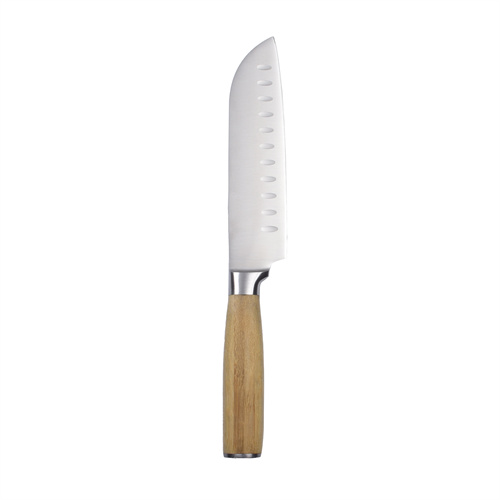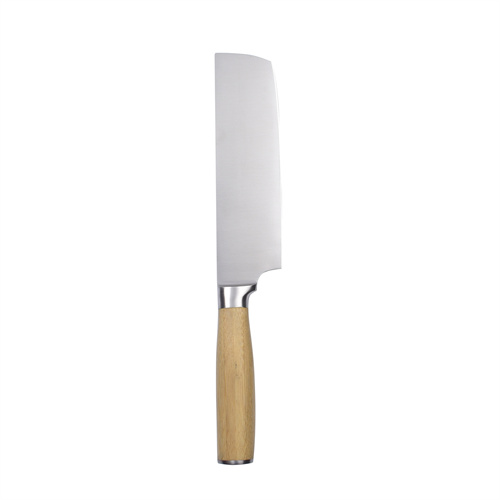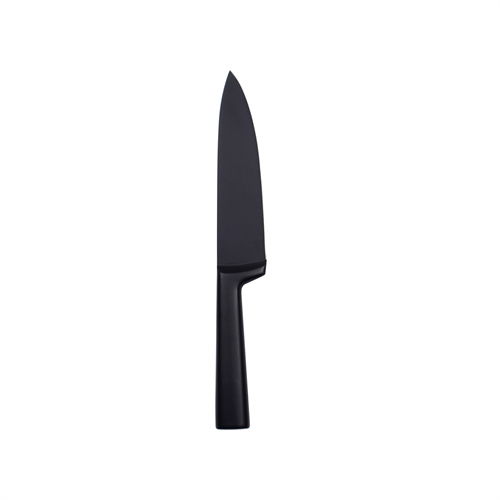

Views: 800 Author: sales@insightknife.com.cn Publish Time: 2025-01-02 Origin: Site








Chef knives are essential tools in any kitchen, prized for their versatility and performance. However, to ensure that these knives remain in top condition, proper care and protection are crucial. This article will explore various methods to protect your chef knife, covering everything from storage solutions to maintenance tips.
A chef knife is a multi-functional tool that can be used for chopping, slicing, dicing, and mincing. Its design allows for a variety of tasks, making it indispensable in both professional and home kitchens. The blade typically ranges from 8 to 12 inches in length, providing a balance between control and cutting power. Given its importance, protecting this tool is vital to maintain its performance and longevity. A well-maintained chef knife not only enhances the cooking experience but also ensures safety, as a sharp knife is less likely to slip and cause accidents.

Chef knives face several risks that can lead to damage, including:
Dulling of the Blade: Frequent use without proper care can dull the blade, making it less effective. A dull knife requires more force to cut through food, which can lead to slips and injuries.
Rust and Corrosion: Exposure to moisture and acidic foods can lead to rust, especially in carbon steel knives. Rust not only affects the knife's appearance but can also compromise its structural integrity.
Physical Damage: Knives can chip or break if not stored properly or if they come into contact with hard surfaces. This damage can render a knife unusable and may require costly repairs or replacement.
Understanding these risks is the first step in implementing effective protection strategies for your chef knife.
Knife blocks are a popular storage solution that keeps knives organized and protected. They provide a safe environment for the blades, preventing them from coming into contact with other utensils that could cause damage. When using a knife block, ensure that the knives are clean and dry before placing them inside. This prevents moisture buildup, which can lead to rust. Additionally, choose a knife block made from high-quality materials that can withstand daily use without deteriorating.
Magnetic strips are an excellent way to store knives while keeping them easily accessible. They allow for air circulation around the blades, reducing the risk of moisture buildup that can lead to rust. When using a magnetic strip, ensure that the knives are securely attached and that the strip is mounted at a safe height to prevent accidents. Magnetic strips also add a modern aesthetic to your kitchen, showcasing your knives as part of your decor while keeping them within reach.
Knife sheaths are protective covers that can be placed over the blades when not in use. They are particularly useful for transporting knives, as they prevent accidental cuts and protect the blade from damage. When selecting a sheath, choose one that fits snugly to prevent movement during transport. Sheaths can be made from various materials, including plastic and leather, and can be customized to fit specific knife sizes, ensuring optimal protection.
For chefs who travel or work in different kitchens, knife rolls are an ideal solution. These portable cases allow for safe storage and transport of multiple knives. A good knife roll will have individual slots for each knife, preventing them from knocking against each other and causing damage. Look for rolls made from durable materials that can withstand wear and tear, and consider options with additional pockets for other essential tools, such as honing rods or kitchen shears.
Keeping your chef knife clean is essential for its longevity. After each use, wash the knife with warm, soapy water and dry it immediately. Avoid soaking the knife in water or placing it in the dishwasher, as this can lead to rust and damage to the handle. Regular cleaning not only prevents food residue buildup but also helps maintain the knife's appearance. For stubborn stains or residues, consider using a soft sponge or cloth to gently scrub the blade without scratching it.
Applying a thin layer of food-safe oil to the blade can help protect it from moisture and rust. This is especially important for carbon steel knives, which are more prone to rusting. Use a clean cloth to apply a small amount of oil, wiping off any excess to avoid a greasy residue. Oiling the blade creates a barrier against moisture and can enhance the knife's appearance, giving it a polished look. Regular oiling, especially after cleaning, can significantly extend the life of your knife.

Regular sharpening is crucial to maintaining the effectiveness of your chef knife. A dull blade requires more force to cut, increasing the risk of accidents. Use a whetstone or a professional sharpening service to keep the blade in optimal condition. It is advisable to sharpen your knife every few months, depending on usage. Learning to sharpen your knife at home can be a valuable skill, allowing you to maintain the edge whenever necessary. Additionally, honing the blade with a honing steel before each use can help realign the edge and keep it sharp longer.
When using your chef knife, avoid cutting on hard surfaces like glass or stone. Instead, use a wooden or plastic cutting board, which will help preserve the sharpness of the blade. A wooden cutting board is particularly beneficial, as it is gentle on the knife's edge and can help prevent dulling. Additionally, avoid using the knife for tasks it is not designed for, such as prying or opening cans. This not only protects the knife but also ensures your safety while cooking.
The handle of a chef knife can be made from various materials, including wood, plastic, and metal. Each material has its advantages and disadvantages. For instance, wooden handles provide a comfortable grip but may require more maintenance to prevent cracking. Plastic handles are durable and easy to clean but may not offer the same aesthetic appeal. Metal handles can be very sturdy but may become slippery when wet. When selecting a knife, consider the handle material that best suits your cooking style and preferences.
Regularly inspect the handle for any signs of wear or damage. If the handle becomes loose or cracked, it may need to be repaired or replaced. Proper care of the handle is just as important as maintaining the blade, as a damaged handle can lead to accidents. Pay attention to the rivets and joints, as these areas can weaken over time. If you notice any issues, consult a professional for repairs to ensure your knife remains safe to use.
When transporting your chef knife, always use a knife guard or sheath. This will protect the blade from damage and prevent accidental cuts. Ensure that the guard fits securely and is made from durable materials to withstand the rigors of travel. Knife guards are especially important for chefs who frequently move between kitchens or attend culinary events, as they provide peace of mind during transport.
For professional chefs, investing in a high-quality knife case is essential. These cases provide ample protection for multiple knives and often include additional compartments for other kitchen tools. Look for cases that are padded and have secure closures to keep your knives safe during transport. A well-designed knife case not only protects your investment but also allows for easy organization, making it simple to find the right tool when needed.
Protecting your chef knife is essential for maintaining its performance and longevity. By implementing proper storage solutions, regular maintenance, and safe transport practices, you can ensure that your knife remains a reliable tool in your kitchen for years to come. Whether you are a professional chef or a home cook, taking the time to care for your chef knife will enhance your culinary experience and keep your kitchen safe. Investing in the right tools and practices will not only preserve the quality of your knife but also elevate your cooking skills, allowing you to create delicious meals with confidence.

The best way to store a chef knife is in a knife block, on a magnetic strip, or in a knife sheath. These storage methods protect the blade from damage and keep it organized. Avoid storing knives in drawers where they can bump against other utensils.
You should sharpen your chef knife every few months, depending on how frequently you use it. Regular honing before each use can help maintain the edge, while professional sharpening or using a whetstone can restore the blade's sharpness when it becomes dull.
No, you should not put your chef knife in the dishwasher. The high heat and harsh detergents can damage the blade and handle. Instead, wash it by hand with warm, soapy water and dry it immediately to prevent rust.
A wooden or plastic cutting board is best for your chef knife. These materials are gentler on the blade compared to glass or stone surfaces, which can dull the knife quickly. Wooden boards also have natural antibacterial properties.
To prevent rust on your chef knife, always dry it immediately after washing, store it in a dry place, and apply a thin layer of food-safe oil to the blade regularly, especially if it is made of carbon steel. Avoid leaving the knife in damp environments or exposing it to acidic foods for extended periods.
What Is The Difference between A Carving Knife And A Chef's Knife?
How Often Should I Sharpen My Bread Knife To Maintain Optimal Performance?
How Do Different Blade Shapes Affect The Performance of A Chef's Knife?
What Are The Best Practices for Storing And Caring for Steak Knives?
Are There Specific Types of Steel That Are Better for Steak Knives?